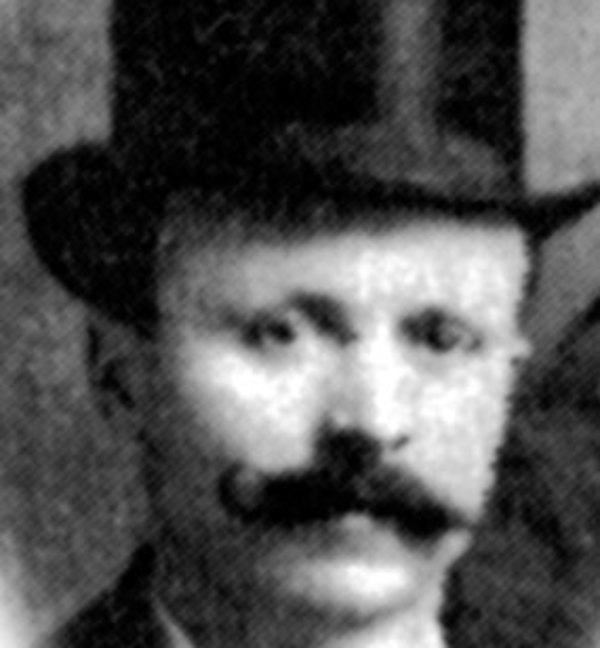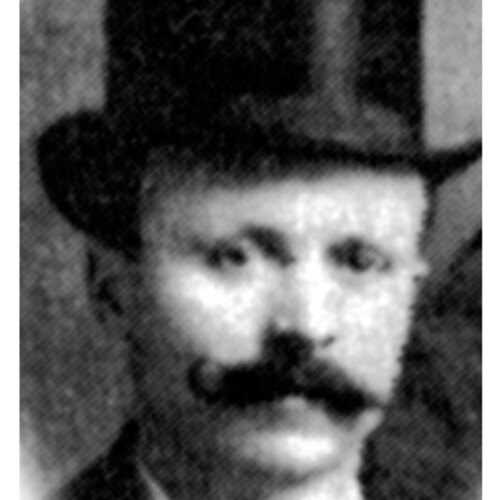
Source: Link
DUNBAR, ROBERT HENRY, bartender, hotel clerk and owner, and athlete; b. 26 Oct. 1859 in Abercrombie, N.S., son of Alexander Dunbar and Margaret Fraser; m. 23 Jan. 1889, in Winnipeg, Nora Gatenby West (d. 1941) of Lucknow, Ont., and they had two daughters and one son; d. 5 June 1937 in Eveleth, Minn.
Robert Henry (Bob) Dunbar was the finest curler of his time, the first of a long line of curling superstars from Winnipeg. He developed tactics and techniques that would have a permanent impact on the sport. Born in Nova Scotia, he moved to Winnipeg as a young man. He may have been there as early as 1878, but city directories have no entry for him until 1882. At that time he was a bartender. Until he left Winnipeg in 1900, he worked as a bartender or hotel clerk, with the exception of a few years during which he was a hotel proprietor.
Dunbar became a prominent athlete in the mid 1880s. Even by late-19th-century standards he was not a big man; he stood just 5 feet, 8 inches tall and weighed 150 pounds. However, he was accomplished in a variety of sports, including boxing, cycling, speed skating, billiards, and several track-and-field events, such as the long jump, shot put, distance races, and sprints. In 1886 he won a 100-yard dash in what the Manitoba Free Press called “perhaps the most exciting sprint race that has ever occurred in this city.” Over 600 spectators watched the contest, and they wagered several thousand dollars on the result. The two competitors, with help from unspecified backers, put up $500 each, an impressive sum for Winnipeg in the 1880s.
The sport in which Dunbar excelled was curling. He did not take up the game until late in the 1880s. A decade later he was considered the top shotmaker in the Canadian west, and therefore probably in the world. At the time there were no national or international championships, but the annual Winnipeg bonspiel held by the Manitoba branch of the Royal Caledonian Curling Club (the Manitoba Curling Association from 1908) was becoming known as the world’s premier curling competition, and it was during these tournaments that he made his reputation.
Dunbar participated in the very first bonspiel of 1889, but he began to skip his own rink (direct his own team) only in 1893. By 1900 his teams had won eight important events, including the Grand Aggregate (the overall championship) twice. In addition, he had won four of the bonspiel’s Grand Points Competitions. A points event, a regular part of bonspiels until the mid 1910s, was a contest for individuals in which participants received a score for each of four attempts at nine different types of shots, such as draws (shots designed to come to rest in the house, or scoring area) and guards (shots intended to stop in front of the house to protect stones in the scoring area). The winner of the points competition was considered the top individual shotmaker.
Late in 1900 Dunbar left for Minnesota and settled in St Paul. He moved there at the request of members of the St Paul Curling Club, who wanted him to instruct other curlers and to take teams to bonspiels outside the city. He made his living as a bartender. Towards the end of 1919 he accepted an invitation to relocate to Eveleth to curl in the local club and to manage a new curling and recreation facility. He would reside there for the rest of his life.
In Minnesota Dunbar remained an elite-level curler, and he was also an important promoter of the sport. On several occasions between 1901 and 1926 he brought rinks north to the Winnipeg bonspiel. His St Paul or Eveleth teams won one Grand Aggregate and tied for a second; they were two of only three non-Canadian teams ever to win a Grand Aggregate in Winnipeg. They also won five other significant events. His teams were state champions of Minnesota eight times. By the late 1920s his son, Robert George, was curling with champion rinks, and the two men were influential in making northeastern Minnesota and northwestern Wisconsin a centre of competitive curling in the United States. Many national champions would come from this district.
The secret to Dunbar’s curling success was his early adoption of a hitting, or knockout, style of play. This approach was different from that which prevailed in the curling world of the late 19th and early 20th centuries: the quiet-weight, draw style left many rocks in play. Essentially, he was the first curler to take advantage of the keen (fast), true ice available in Winnipeg and most parts of the Canadian prairies. Dunbar could execute all the standard shots, but he was remarkable at takeouts (striking an opponent’s stone to remove it from play). When he died, one Winnipeg sportswriter paid tribute by saying that “no skip was ever capable of doing so much damage to an opponent’s carefully built-up end as Bob Dunbar with his last two shots. He was devastating.”
The hitting game that Dunbar developed placed a premium on accuracy, and to facilitate it he adopted an early form of the shoulders-square-to-the-target, sliding delivery that all good curlers now use. Dunbar was not the first to employ a face-the-target stance: in sketches and paintings, one can find earlier curlers in this pose. When Dunbar began to curl, however, most of his contemporaries delivered the stone from the shoulders-sideways-to-the-target stance that had evolved owing to the use of portable foot grips and poorly constructed hacks (footholds). Dunbar learned that he was much more accurate if he faced the direction of his shot. Because he wanted to throw hitting weight (throw fast), he needed thrust from his pushing leg, so he bent his legs more and his waist less than other curlers. He practised for hours by himself, and he discovered that his delivery was smoother and more accurate if he allowed the momentum from his push to carry him a short distance out of the hack. He stopped before he hit the back of the rings, which meant that he travelled less than six feet. But Dunbar was sliding, as curlers do today.
In the first half of the 20th century, the curling world came to associate Winnipeg, and increasingly the prairie west, with highly skilled curlers who favoured a hitting style. In the winter of 1922–23 a large group of curlers from Scotland visited cities in Canada and the United States, and they left a record of their tour. They acknowledged that they could not compete with the top Winnipeg shotmakers, whose “splendid running and rolling game” seemed boring but was mercilessly efficient. They noted that a hitting style of play prevailed in Minnesota, but not in the rest of the United States. The superiority of Winnipeg teams was confirmed when an annual national men’s curling championship, the Brier, was established in 1927. Between 1927 and 1952 the Brier was held 23 times (it was cancelled in 1943, 1944, and 1945), and 12 of the winning teams, skipped by 8 different men, came from Winnipeg. Most of the Winnipeg championship teams excelled at hitting.
The sliding delivery that Dunbar had pioneered was refined and developed by Winnipeggers such as Frank Cassidy in the 1900s and 1910s, Gordon Hudson in the 1910s and 1920s, and the brothers James Kenneth (Ken) and Grant G. Watson in the 1920s, 1930s, and 1940s. Through his newspaper columns, his books, and especially his remarkable performances on the ice, Ken Watson taught the sliding delivery to the world. By the 1960s almost every accomplished curler, now aided by artificial ice and slippery-soled shoes, was using the slide. Watson acknowledged the debt owed to Dunbar by all competitive curlers.
Robert Henry Dunbar died at his home of an illness that lasted almost a year. The Nova Scotian–Manitoban–Minnesotan was one of the few athletes who not only excelled at a sport but also changed it forever.
Church of Jesus Christ of Latter-day Saints, “International geneal. index”: www.familysearch.org (consulted 7 Dec. 2017). Man., Dept. of Justice, Vital statistics agency (Winnipeg), no.1889-001954. Eveleth Clarion (Eveleth, Minn.), 10 June 1937. Manitoba Free Press, 13 May 1884; 2 July 1885; 8 April, 19 May, 21 June, 14 Aug. 1886; 7 March 1889; 15 Feb. 1894; 18 Oct. 1900; 22 Feb. 1902; 7 Feb. 1903; 10 Jan. 1906; 10 Feb. 1920. Winnipeg Free Press, 7 March 1936; 11 Feb., 7, 8 June 1937; 9 Dec. 1948; 22 Jan. 1953; 14 Nov. 1977. Winnipeg Tribune, 8 Jan. 1910; 8 June 1937; 5, 9 Feb. 1955. A. G. Backstrom, “The legend of Bob Dunbar,” North American Curling News (Portage, Wis.), 20 (1964): 22–23. W. A. Creelman, Curling, past and present … (Toronto, 1950). Directory, Winnipeg, 1882–1900. R. A. Howe, “The development of curling in the United States” (pe.d. thesis, Ind. Univ., Bloomington, 1968). John Kerr, Curling in Canada and the United States: a record of the tour of the Scottish team, 1902–3, and of the game in the dominion and the republic (Edinburgh and Toronto, 1904); The history of curling and fifty years of the Royal Caledonian Curling Club (Edinburgh, 1890). M. H. Marshall, The Scottish curlers in Canada and U.S.A.: a record of their tour in 1922–23 (Edinburgh, 1924). Doug Maxwell, Canada curls: the illustrated history of curling in Canada (North Vancouver, B.C., 2002). Morris Mott and John Allardyce, Curling capital: Winnipeg and the roarin’ game, 1876 to 1988 (Winnipeg, 1989). J. K. Munro, “Curling in Canada,” Canadian Magazine, 18 (November 1901–April 1902): 527–34. W. H. Murray, The curling companion (rev. ed., Toronto, 1982). Vera Pezer, The stone age: a social history of curling on the prairies (Calgary, 2003). Gerald Redmond, The sporting Scots of nineteenth-century Canada (Rutherford, N.J., 1982). Royal Caledonian Curling Club of Scotland, Man. Branch, Annual (Winnipeg), 1889–1901. D. B. Smith, Curling: an illustrated history (Edinburgh, 1981). J. A. Stevenson, Curling in Ontario, 1846–1946 (Toronto, 1950). Ken Watson, Ken Watson on curling (Vancouver, 1950). H. J. Woodside, “Curling in the northwest,” Outing (New York and London), 25 (October 1894–March 1895): 422–27, 497–503.
Cite This Article
Morris Mott, “DUNBAR, ROBERT H.,” in Dictionary of Canadian Biography, vol. 16, University of Toronto/Université Laval, 2003–, accessed January 19, 2026, https://www.biographi.ca/en/bio/dunbar_robert_henry_16E.html.
The citation above shows the format for footnotes and endnotes according to the Chicago manual of style (16th edition). Information to be used in other citation formats:
| Permalink: | https://www.biographi.ca/en/bio/dunbar_robert_henry_16E.html |
| Author of Article: | Morris Mott |
| Title of Article: | DUNBAR, ROBERT H. |
| Publication Name: | Dictionary of Canadian Biography, vol. 16 |
| Publisher: | University of Toronto/Université Laval |
| Year of publication: | 2019 |
| Year of revision: | 2019 |
| Access Date: | January 19, 2026 |



